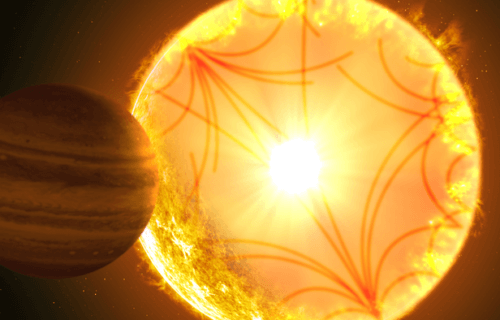PRINCETON, N.J. — An alien planet spotted spiraling toward its doom around an aging star may be a preview of how our world will die in the future.
Astronomers say that the dying planet could help answer questions about the fate of other worlds as their solar systems evolve. It is the first time that astronomers have discovered an exoplanet whose orbit is decaying around its host star.
Researchers say the planet, called Kepler-1658b, appears destined to spiral closer and closer to its maturing star until it ultimately collides and burns up. The discovery offers new insights into the process of planetary orbital decay by providing scientists with their first live look at a solar system in that stage of its evolution.
Researchers believe “death-by-star” is a fate that many planets — including Earth — will suffer billions of years from now as their suns grows older.
“We’ve previously detected evidence for exoplanets in-spiraling toward their stars, but we have never before seen such a planet around an evolved star,” says first author Shreyas Vissapragada, a 51 Pegasi b Fellow at Harvard University and the Smithsonian Institution, in a university release.
“Theory predicts that evolved stars are very effective at sapping energy from their planets’ orbits, and now we can test those theories with observations,” Vissapragada continues.
Astronomers discovered Kepler-1658b with the Kepler space telescope, which is on a pioneering planet-hunting mission that launched in 2009. Kepler-1658b the very first exoplanet candidate Kepler observed, but it took nearly a decade to confirm its existence. By that time, the object entered Kepler’s catalogue officially as the 1,658th entry.
Kepler-1658b is also called a “hot Jupiter” — the nickname exoplanets receive if they’re on par with Jupiter’s mass and size, but they’re in an ultra-close and scorching-hot orbit around their host stars. For Kepler-1658b, that distance is just an eighth of the distance between our Sun and its closest orbiting planet, Mercury.
For hot Jupiters and other planets like Kepler-1658b that are very close to their stars, orbital decay makes the planet’s destruction a near lock to take place. Measuring the orbital decay of exoplanets has been difficult for scientists because the process is gradual and occurs very slowly.
In the case of Kepler-1658b, its orbital period is decreasing at the miniscule rate of about 131 milliseconds per year. A shorter orbit means the planet is moving closer to its star, according to the study published in The Astrophysical Journal Letters. Detecting this decline took many years of careful observation.
The monitoring of this planet started with Kepler, before the Palomar Observatory’s Hale Telescope in Southern California picked up the study, and finally the Transiting Exoplanet Survey Telescope, or TESS, which launched in 2018. All three instruments captured transits, the term for when an exoplanet crosses the face of its star and causes a very slight dimming of the star’s brightness from our perspective.
Over the past 13 years, the time between Kepler-1658b’s transits has been slightly but steadily decreasing. Scientists say that the root cause of the orbital decay comes down to tides — the same phenomenon responsible for the daily rise and fall in Earth’s oceans.
Tides are generated by gravitational interactions between two orbiting objects, like the interactions between Earth and the Moon — or Kepler-1658b and its star. The bodies’ gravities alter each other’s shapes, and as the bodies respond to these changes, it releases energy.
Depending on the distances between, sizes, and rotational rates of the bodies involved, the tidal interactions can result in these objects pushing each other away. The team says this is the case for Earth and the slowly outward-spiraling Moon. Conversely, it’s an inward spiral for Kepler-1658b and its star.
Dr. Vissapragada explains that Kepler-1658b’s star has evolved to the point where it’s starting to expand, just as our sun will one day. This is what astronomers call the subgiant phase.
“The internal structure of evolved stars should more readily lead to dissipation of tidal energy taken from hosted planets’ orbits compared to unevolved stars like our Sun,” Vissapragada says, according to a statement from SWNS.
“This accelerates the orbital decay process, making it easier to study on human timescales. The results further help in explaining an intrinsic oddity about Kepler-1658b, which appears brighter and hotter than expected. The tidal interactions shrinking the planet’s orbit may also be cranking out extra energy within the planet itself.”
Dr. Vissapragada points to a similar situation with Jupiter’s moon Io, the most volcanic body in the solar system. The researcher says the gravitational push-and-pull from Jupiter on Io melts the planet’s interior. This molten rock then erupts out onto the moon’s surface of yellow sulfurous deposits — giving it an almost pizza-like appearance.
“Now that we have evidence of in-spiraling of a planet around an evolved star, we can really start to refine our models of tidal physics,” Dr. Vissapragada tells SWNS.
“The Kepler-1658 system can serve as a celestial laboratory in this way for years to come, and with any luck, there will soon be many more of these labs. I can’t wait to see what all of us end up discovering together.”
“Even though physically, this exoplanet’s system is very dissimilar to our solar system — our home — it can still tell us a lot about the efficiency of these tidal dissipation processes, and how long these planets can survive,” adds Ashley Chontos, the Henry Norris Russell Postdoctoral Fellow in Astrophysics at Princeton.
South West News Service writer Stephen Beech contributed to this report.
